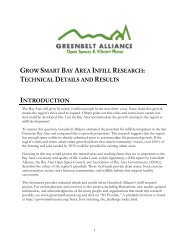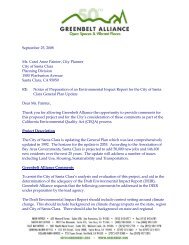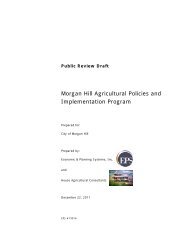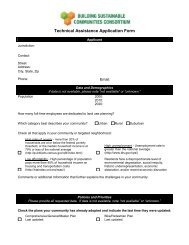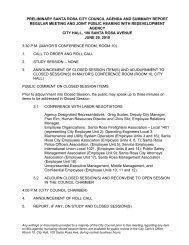You also want an ePaper? Increase the reach of your titles
YUMPU automatically turns print PDFs into web optimized ePapers that Google loves.
Parcelization<br />
Land parcelization is a hidden—but critical—threat to the<br />
long-term integrity of the Bay Area’s greenbelt. Parcelization<br />
occurs when undeveloped land is divided up into<br />
smaller pieces that can be used as house lots. Parcelized<br />
areas are usually built out in a piecemeal fashion, as<br />
individual lot owners gradually put up houses. This means<br />
sprawl can occur largely outside of public view and with<br />
little planning or oversight.<br />
Most parcelized lands are near cities or existing development.<br />
Once built upon, they create all the same problems<br />
as traditional sprawling subdivisions.<br />
Parcelized lands that are farther away from cities pose<br />
significant problems of their own. Parcelization can<br />
fragment areas deep within the greenbelt, breaking up<br />
contiguous blocks of habitat essential for many wildlife<br />
species, or carving up otherwise-intact farming areas. This<br />
process also puts large demands on rural roads and other<br />
infrastructure, generally in places that are very expensive<br />
to service, creating pressure for sprawl-inducing infrastructure<br />
expansion. Ultimately, by undermining the<br />
values of an intact greenbelt, parcelization makes it more<br />
likely that a given area will be converted to full-blown<br />
suburban sprawl in the future.<br />
Parcelization is a threat in every Bay Area county except<br />
San Francisco, but is especially acute in Sonoma and Santa<br />
Clara Counties. Sonoma County has the second-most atrisk<br />
land of any county in the Bay Area, despite having<br />
urban growth boundaries around eight of its nine cities.<br />
One key reason is that parcelization threatens large areas<br />
of the county, even on extremely productive farmland<br />
(Figure 6). Of all the land at risk in Sonoma County,<br />
24%—a total of 20,810 acres—is threatened primarily by<br />
parcelization. It is the most parcelized county in California.<br />
Alameda County has been effective at stopping parcelization<br />
through the use of large minimum lot sizes on county<br />
land. Napa County and Solano County, on the other hand,<br />
have limited parcelization threats with initiatives that<br />
restrict residential development on unincorporated county<br />
or agricultural land. The latter approach may work better<br />
in areas where commercially viable farms can be small,<br />
such as in Sonoma’s vineyards. Nonetheless, because<br />
parcelization often happens under the radar, it will require<br />
continued vigilance on the part of Bay Area counties to<br />
prevent it from gradually eroding the region’s greenbelt.<br />
Pa r c e l S i z e ( A c r e s )<br />
5–9<br />
10–39<br />
40–159<br />
160–599<br />
> 600<br />
Protected Land<br />
Urban<br />
k N<br />
5 Miles<br />
Figure 6: Land Parcelization in Sonoma County<br />
16 <strong>At</strong> <strong>Risk</strong>: The Bay Area <strong>Greenbelt</strong>




